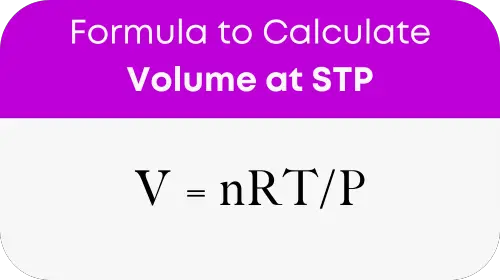The Volume at STP Calculator is designed to calculate the volume of a gas at Standard Temperature and Pressure (STP), conditions predefined as 0 °C (273.15 K) and 1 atm pressure. This tool is invaluable for chemists, students, and professionals dealing with gases, facilitating the conversion of gas quantities in moles to their equivalent volume in liters at STP, thus supporting accurate measurements and experimental results.
Formula of Volume at STP Calculator
The cornerstone of this calculator is the ideal gas law, which establishes a relationship between the pressure (P), volume (V), temperature (T), and the number of moles (n) of a gas. At STP, simplifications lead to a direct formula:

Where:
- V is the volume of the gas (in liters)
- n is the number of moles of the gas
- R is the universal gas constant (0.0821 L atm/mol K)
- T is the temperature in Kelvin (K)
- P is the pressure (in atm)
At STP, with T=273.15 K and P=1 atm, the formula simplifies to:
V = n * 0.0224 L/mol
This simplified equation directly links the number of moles of a gas to its volume at STP, making it straightforward to calculate one from the other without complex conversions.
Volume of Common Gases at STP
| No. of Moles (n) | Volume at STP (L) |
|---|---|
| 1 | 22.4 |
| 2 | 44.8 |
| 3 | 67.2 |
| 4 | 89.6 |
| 5 | 112 |
| 10 | 224 |
| 15 | 336 |
| 20 | 448 |
| 25 | 560 |
| 30 | 672 |
| 50 | 1120 |
| 100 | 2240 |
Example of Volume at STP Calculator
Let’s apply the formula with a practical example to illustrate its use:
If we have 2 moles of oxygen gas (O₂), the volume at STP can be calculated as:
V = 2 * 0.0224 L/mol = 0.0448 L
This result means that 2 moles of oxygen gas occupy 44.8 liters at standard temperature and pressure.
Most Common FAQs
STP stands for Standard Temperature and Pressure, defined as 0 °C (273.15 K) and 1 atmosphere (atm) of pressure. These conditions provide a reference for comparing gas volumes.
The calculator is highly accurate within the theoretical framework of the ideal gas law. However, real gases may exhibit slight deviations under certain conditions.
Yes, the formula applies universally to all ideal gases. For real gases, it remains a good approximation under a wide range of conditions.